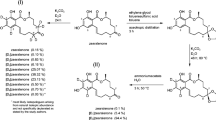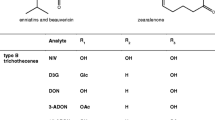Abstract
The Alternaria mycotoxin tenuazonic acid (TA) was quantified in fruit juices (n = 50), cereals (n = 12) and spices (n = 38) using a recently developed stable isotope dilution assay (SIDA). [13 C6,15 N]-TA was used as the internal standard. Method validation revealed low limits of detection (LODs) of 0.15 μg/kg (fruit juices), 1.0 μg/kg (cereals) and 17 μg/kg (spices). The respective limits of quantitation were about three times higher. Recovery was about 100% for all matrices. The precision (relative standard deviation of replicate analyses of naturally contaminated samples) was 4.2% (grape juice; 1.7 μg/kg), 3.5% (whole wheat flour; 36 μg/kg) and 0.9% (curry powder; 215 μg/kg). The median content of TA in the analyzed samples was 1.8 μg/kg (fruit juices), 16 μg/kg (cereals) and 500 μg/kg (spices). Positive samples amounted to 86% (fruit juices), 92% (cereals) and 87% (spices).





Similar content being viewed by others
References
Asam S, Konitzer K, Schieberle P, Rychlik M (2009) Stable isotope dilution assays of alternariol and alternariol monomethyl ether in beverages. J Agric Food Chem 57:5152–5160
Asam S, Liu Y, Konitzer K, Rychlik M (2011) Development of a stable isotope dilution assay for tenuazonic acid. J Agric Food Chem 59:2980–2987
Azcarate MP, Patriarca A, Terminiello L, Pinto VF (2008) Alternaria toxins in wheat during the 2004 to 2005 Argentinean harvest. J Food Prot 71:1262–1265
Boonzaaijer G, van Osenbruggen WA, Kleinnijenhuis AJ, van Dongen WD (2008) An exploratory investigation of several mycotoxins and their natural occurrence in flavour ingredients and spices, using al multi-mycotoxin LC-MS/MS method. World Mycotoxin J 1:167–174
Bottalico A, Logrieco A (1998) Toxigenic Alternaria species of economic importance. In: Kaushal K, Bhatnagar D (eds) Mycotoxins in Agriculture and Food Safety. Marcel Dekker, New York, pp 65–108
Brady OL, Elsmie GV (1926) The use of 2:4-dinitrophenylhydrazine as a reagent for aldehydes and ketones. Analyst 51:77–78
Combina M, Dalcero AM, Torres A (1998) Spectrometric studies on stability of tenuazonic acid (TeA) solution in organic solvents. Mycotoxin Res 14:54–59
Da Motta S, Soares LMV (2001) Survey of Brazilian tomato products for alternariol, alternariol monomethyl ether, tenuazonic acid and cyclopiazonic acid. Food Addit Contam 18:630–634
Fazekas B, Tar A, Kovacs M (2005) Aflatoxin and ochratoxin A content of spices in Hungary. Food Addit Contamin 22:856–863
Hernandez-Hierro JM, Garcia-Villanova RJ, Torrero PR, Toruno-Fonseca IM (2008) Aflatoxins and ochratoxin A in red paprika for retail sale in Spain: Occurrence and evaluation of a simultaneous analytical method. J Agric Food Chem 56:751–756
Lau BPY, Scott PM, Lewis D, Kanhere S, Cleroux C, Roscoe V (2003) Liquid chromatography-mass spectroscopy and liquid chromatography-tandem mass spectroscopy of Alternaria mycotoxins alternariol and alternariol monomethylether in fruit juices and beverages. J Chromatogr A 998:119–131
Li FQ, Yoshizawa T (2000) Alternaria Mycotoxins in Weathered Wheat from China. J Agric Food Chem 48:2920–2924
Miller FA, Rightsel WA, Sloan BJ, Ehrlich J, French JC, Bartz QR, Dixon GJ (1963) Antiviral Activity of tenuazonic acid. Nature 200:1338–1339
Mislivec PB, Bruce VR, Stack ME, Bandler R (1987) Molds and tenuazonic acid in fresh tomatoes used for catsup production. J Food Prot 50:38–41
Patriarca A, Azcarate MP, Terminiello L, Pinto VF (2007) Mycotoxin production by Alternaria strains from Argentinean wheat. Int J Food Microbiol 119:219–222
Pinto VF (2008) Detection and determination of Alternaria mycotoxins in fruits and vegetables. In: Barkai-Golan R, Paster N (eds) mycotoxins in fruits and vegetables, 1st edn. Elsevier, San Diego, pp 271–278
Rosett T, Sankhala RH, Stickings CE, Taylor MEU, Thomas R (1957) Studies in the biochemistry of micro-organisms. Metabolites of Alternaria Tenuis Auct.: Culture Filtrate Products. Biochem J 67:390–400
Rychlik M, Asam S (2008) Stable isotope dilution assays in mycotoxin analysis. Anal Bioanal Chem 390:617–628
Santos L, Marín S, Sanchis V, Ramos AJ (2010) Co-occurrence of aflatoxins, ochratoxin A and zearalenone in Capsicum powder samples available on the Spanish market. Food Chem 122:826–830
Scott PM (2001) Analysis of agricultural commodities and foods for Alternaria mycotoxins. J AOAC Int 84:1809–1817
Scott PM, Kanhere SR (1980) Liquid chromatographic determination of tenuazonic acids in tomato paste. J Assoc Off Anal Chem 63:612–621
Scott PM, Lawrence GA, Lau BPY (2006) Analysis of wines, grape juices and cranberry juices for Alternaria toxins. Mycotoxin Res 22:142–147
Scott PM, Stoltz DR (1980) Mutagens produced by Alternaria alternata. Mutat Res 78:33–40
Shephard GS, Thiel PG, Sydenham EW, Vleggaar R, Marasas WFO (1991) Reversed-phase high-performance liquid chromatography of tenuazonic acid and related tetramic acids. J Chromatogr Biomed Appl 566:195–205
Shigeura HT, Gordon CN (1963) The biological activity of tenuazonic acid. Biochemistry 2:1132–1137
Siegel D, Merkel S, Koch M, Nehls I (2010) Quantification of the Alternaria mycotoxin tenuazonic acid in beer. Food Chem 120:902–906
Siegel D, Rasenko T, Koch M, Nehls I (2009) Determination of the Alternaria mycotoxin tenuazonic acid in cereals by high-performance liquid chromatography–electrospray ionization ion-trap multistage mass spectrometry after derivatization with 2,4-dinitrophenylhydrazine. J Chromatogr A 1216:4582–4588
Smith ER, Fredrickson TN, Hadidian Z (1968) Toxic effects of the sodium and the N, N'-dibenzylethylenediamine salts of tenuazonic acid (NSC-525816 and NSC-82260). Cancer Chemother Rep 52:579–585
Stack ME, Mislivec PB, Roach JAG, Pohland AE (1985) Liquid chromatographic determination of tenuazonic acid and alternariol methyl ether in tomatoes and tomato products. J Assoc Off Anal Chem 68:640–642
Steyn PS, Rabiet CJ (1976) Characterization of magnesium and calcium tenuazonate from Phoma Sorghina. Phytochemistry 15:1977–1979
Stickings CE (1959) Studies in the biochemistry of micro-organisms. Metabolites of Alternaria Tenuis Auct.: the structure of tenuazonic acid. Biochem J 72:332–340
Terminiello L, Patriarca A, Pose G, Pinto VF (2006) Occurrence of alternariol, alternariol monomethyl ether and tenuazonic acid in Argentinean tomato puree. Mycotoxin Res 22:236–240
Umetsu N, Kaji J, Aoyama K, Tamari K (1974) Toxins in blast-diseased rice plants. Agric Biol Chem 38:1867–1874
Umetsu N, Kaji J, Tamari K (1972) Investigation on the toxin production by several blast fungus strains and isolation of tenuazonic acid as a novel toxin. Agric Biol Chem 36:859–866
Vogelgesang J, Hädrich J (1998) Limits of detection, identification and determination: a statistical approach for practitioners. Accred Qual Assur 3:242–255
Webley DJ, Jackson KL, Mullins JD, Hocking AD, Pitt JI (1997) Alternaria toxins in weather-damaged wheat and sorghum in the 1995–1996 Australian harvest. Aust J Agric Res 48:1249–1255
Conflict of Interest
None
Author information
Authors and Affiliations
Corresponding author
Rights and permissions
About this article
Cite this article
Asam, S., Lichtenegger, M., Liu, Y. et al. Content of the Alternaria mycotoxin tenuazonic acid in food commodities determined by a stable isotope dilution assay. Mycotoxin Res 28, 9–15 (2012). https://doi.org/10.1007/s12550-011-0111-x
Received:
Revised:
Accepted:
Published:
Issue Date:
DOI: https://doi.org/10.1007/s12550-011-0111-x




